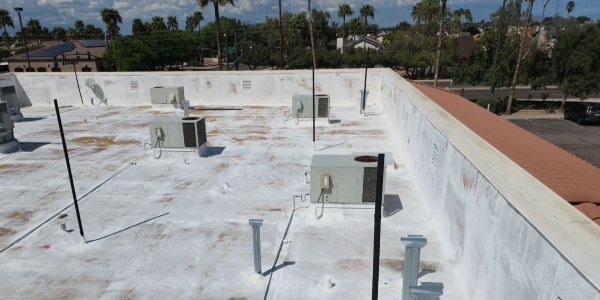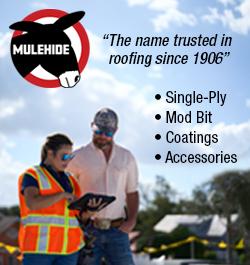UP TO THE MINUTE
Have spray polyurethane foam roofing questions? We have the answers!

By Western Colloid.
Here’s your complete guide to spray polyurethane foam roofing restoration, including installation tips, benefits and maintenance.
Spray Polyurethane Foam, commonly known as SPF roofing, is made up of a mixture of a few chemicals that are then sprayed using a specialized gun. While spraying, the gun mixes the chemicals in the spray tip, which allows them to expand once combined. SPF is similar to the foam you’ll find in insulated ice chests and it creates great insulation on roofs. As SPF technology has developed, people started spraying it on many things, including cold rooms and tanks, and it was eventually adapted to roofs.
In using SPF for roofs, roofers discovered that foam by itself breaks down quite dramatically when it is exposed to UV — the cells would open up and instead of keeping water out, it would actually suck water into the roof. In order to use SPF on a roof, the roofing industry had to come up with a protective surface for the foam.
That’s when we began using acrylic roof coatings, usually embedded with roofing granules similar to rolled roofing cap sheets. Granules are also good for bird resistance because birds like to peck at foam. SPF roofs create great insulation, and they are also a good barrier against weather damage.
As with any system, some roof decks worked with SPF better than others. Plywood deck roofs were harder to install SPF on because the plywood flexed and moved damaging the foam. Contractors have also faced problems with applying SPF over metal roofs because they have a great deal of movement and can cause SPF to split and buckle.
Maintenance is key for foam roofs
What we here at Western Colloid have found over the years is that once that protective surface breaks down, it is difficult to make repairs. We are members of the Spray Polyurethane Foam Alliance (SPFA) and have been for decades. Although we don’t offer SPF roofing products, we're involved in this industry because we offer repair products for people with foam roofs.
It’s recommended that building owners keep up with maintaining their surface coating system. Whether it's seven, eight or nine years, they should recoat their foam roof to extend their life. Unfortunately, owners that don’t maintain their roof end up with foam roofs that are degrading.
That brings us to where we are today with SPF roofs. There are still a lot of SPF roofs out there, and the ones that haven't been treated well are some of the most problematic roofs you can run across. Some roofs cannot be saved because they've deteriorated to such an extent that the foam has broken down and it can soak up water like a sponge. Once SPF becomes exposed to UV damage, the exposed area is called “fried foam.” This is when the SPF has become soft, dusty or very brittle.
One option to remediating the SPF roof is by “scarifying” the foam. Scarifying means using a machine that’s similar to a lawnmower – it has blades that grind down into the foam until they get to a good layer of foam. And then, while that is very fresh, another layer of foam is applied over it and then recoat that.
Deteriorated SPF roofs can hold water forever
Occasionally a contractor will be restoring a roof with our Fluid Applied Reinforced Roof (FARR) system over the top of a foam roof with hidden water intrusion and it will blister. This happens because there's no place for that water to go. If it’s a metal deck that the water can't go down, it comes up. When the roof heats up it will blister. Blisters are mainly an aesthetics issue, but those roofs are probably holding water and it’s difficult to tell where that water is being held.
To repair a deteriorated SPF roof, you can cut the blisters out in the summer and try and let that roof bake out a bit. Then you can recoat it with a membrane over the top of it for the fall season.
SPF roofs are among the hardest roof to identify damage
With a built-up roof you can look around the drains and waterways to see deterioration, that is not the case with SPF. The best solution is with a moisture scan. If you find moisture, you can cut out and re-foam a three foot by three foot, or six foot by six-foot area. From there, you can bring it back to the same level as the existing foam, then apply a FARR system.
SPF roofs can hide a bunch of secrets unlike a built-up roof. In most cases SPF is the second roof. You’ll want to raise the curbs, pipes and the roof jacks, then cut them out and reposition them. When making these kinds of repairs, there are now foam kits that you can use.
Foam packs are convenient and they will also work with board stock insulation. You can find everything from a can of foam to small spray kits. Using these, you can spray a larger area with two bottles that connect with a hose to fill it. When repairing a blister, you can fill the void with one of these kits.
Contractors also use a lightweight mortar mix with cement to fix patches. They mix it and can then fix those voids and low spots that have been cut out. Then a FARR system can be applied.
Western Colloid’s #800 acrylic mastic is useful for SPF roof repairs. It has a water base and it’s very elastomeric. It can be used to easily repair cracks, splits and small depressions. If the defects are over a quarter of an inch thick, a three-course specification with polyester fabric is needed.
The issue with skylights
Skylights have a nice curb and water can easily run around them. When applying foam on a roof, sometimes contractors fill within a half an inch of the edge of the skylight. But when it rains, the water is going to run up and into the skylight. This can be avoided by controlling the roof’s drainage.
Foam can be added around drains and crickets. If done properly, water can flow right to a drain or a scupper. If there's a situation where water is holding in an area, contractors can shave the foam back two or three feet and make a nice drain sump where, which creates positive drainage on a roof. Then a Western Colloid system can be installed over it.
Making the most of an SPF roof
To increase the performance of an SPF roof, it’s recommended that a cool roof protective coating is installed over the foam roof to help the foam fight as little heat as possible to give it more value.
Installing a foam roof is a real art form. When a contractor goes out to a job, they will likely have a little weather station built onto their equipment – they’ll know the humidity, the air movement, the wind speed and they’ll record that for future reference. And when a foam applicator applies SPF it's beautiful and it lays out very smoothly.
Original article source: Western Colloid
Learn more about Western Colloid Fluid Applied Roofing and Coating Systems in their Coffee Shop Directory or visit www.westerncolloid.com.



















Comments
Leave a Reply
Have an account? Login to leave a comment!
Sign In